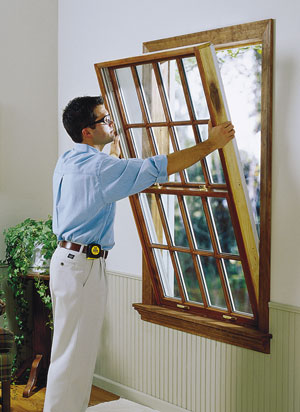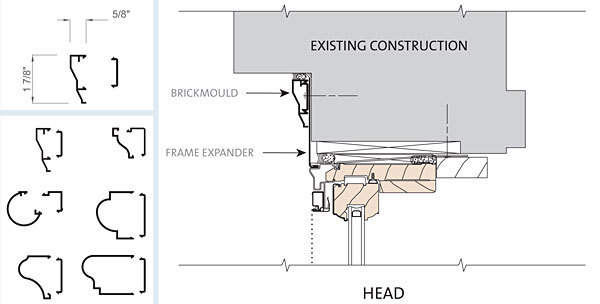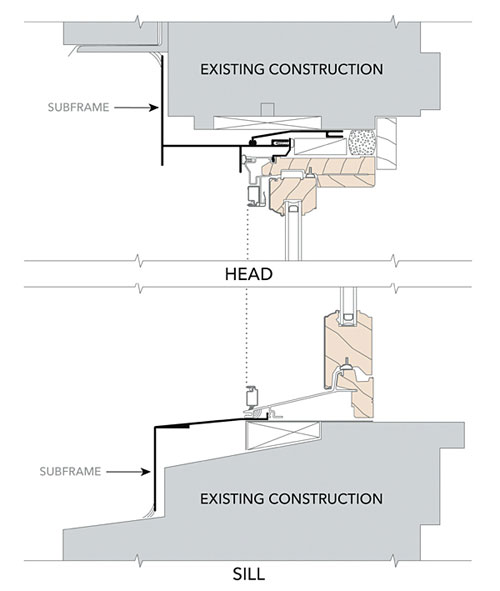Window Replacement Solutions for Commercial and Institutional Buildings
Replacement by Retaining Window Frames and Replacing Sash
This is a more commonly used approach to window replacement recognizing that the frame and trim that is already installed in the exterior wall may be fully serviceable still, but the operable or fixed sash may need replacing. It saves on the labor costs associated with the complete tear out approach, but also assumes that other considerations can be met through the re-use of the existing frame and trim. Indeed, that reuse may enhance historic or maintenance considerations depending on the project.
Recognizing the need for affordable custom sized replacement windows, many window manufacturers offer not only the window sash units, but complete window replacement systems designed to accommodate a variety of applications. Five commonly available types of such systems are described below:
-
Pocket Installation. This is an excellent and very economical choice for applications where the existing frames are in good condition and only the sash needs to be replaced. The new window sash is factory-assembled into a thin wooden frame that essentially creates a full window unit that is custom made to slide easily into the existing frame or "pocket". Because it is a full unit, it can be tested for compliance with applicable ASTM and other standards. The result is a high quality window with a faster installation that eliminates the cost and complexity of a complete tear-out.
Pocket installation replacement window
Photo courtesy of Pella Corporation
This pre-assembled system is a notable improvement over older pocket systems, still offered by some window manufacturers, that rely on a "sash kit" of parts and pieces to be field installed. The sash kit is understandably a more time consuming and labor intensive installation that foregoes the possibility of factory controlled conditions and testing to achieve a predictable end result. In situations where performance is important related to energy efficiency, wind and weather penetration, or overall structural integrity is key, the fully assembled pocket installation is usually preferred.
In either type of pocket installation, though, adjacent wall, ceiling, and floor surfaces are not usually impacted, meaning that existing trim, wallcoverings, paint and plaster are not disturbed.
- Frame Expanders.In applications where the existing wood or metal windows are accessible from the exterior, the use of a frame expander approach can be quite appropriate. It is essentially the same as a Pocket Installation but adds an additional exterior
aluminum piece to the new aluminum-clad wood frame that can update the appearance of the exterior trim or cover existing trim that is in poor condition. This is still an economical method of window replacement since it retains all of the features of a pocket installation - the existing window frames do not need to be removed and the sash and adjacent finished surfaces aren't affected. Further, any deteriorated exterior conditions that might otherwise need to be removed or replaced can be covered over. The pre-finished, low maintenance aluminum trim of the frame expander can be designed and specified to cover the existing exterior trim in a style to either match or complement the existing. The new trim profile can usually replicate flat casing, brickmould,
or even custom and historical shapes. The end result is an improved exterior appearance in addition to the window sash replacement.
 |
Detail drawing of expanded frame trim options Drawings courtesy of Pella Corporation |
- Standard Subframe. When a project calls for replacement of existing wood windows but with access from the interior of the building, then a standard subframe approach will make sense. The labor costs with this approach are controlled since it allows
for interior installation and eliminates the need for exterior scaffolding or lifts. In this case the subframe is added to the wooden frame of a pocket installation but passed through the opening from the inside of the building and installed to the opening perimeter. It is similar to a frame expander in that it is typically made of low maintenance, pre-finished aluminum but acts as an installation "receptor" for the new window in addition to a trim feature. After removing the existing sash, but before installing the new, the standard subframe is pre-assembled and installed into the existing opening, thus concealing the existing wood window frame and any deficiencies it may contain. The subframe receives the new window sash pocket unit and secures it in place. Aesthetically,
the subframe by itself provides the look of finished flat casing and sets the window back inside the opening producing desirable shadow lines at the window. Most manufacturers will also provide matching aluminum accessories where desired such as subframe expanders, mullion trim, and brickmould profiles.
 |
Installation details drawing for standard subframe Drawings courtesy of Pella Corporation |









